
Past papers exam questions and answers
Revision is more than memorising facts and going over notes. You can practise an exam by answering CPA kasneb past exam questions from past papers. This will give you a better chance of passing.
By practising with real past examination papers you will:
- Find out if you have learnt enough to tackle CPA kasneb exams
- Identify any weakness that you may have in answering questions
- Learn about how the exam questions are answered.
Once you have completed a paper, you can compare your answers against the marking scheme. With the many past papers provided in our revision kits you will increase your chance of passing the upcoming exams.
Management Accounting Revision Kit – Past exam questions and answers for kasneb CPA, CS and CCP courses
This revision kit consists of kasneb past paper questions and their suggested answers to act as a revision guide for those students taking kasneb courses.
Full Access to these notes/Kit on Desktop/Laptop via https://desktop.someakenya.co.ke
Or through Our Mobile App



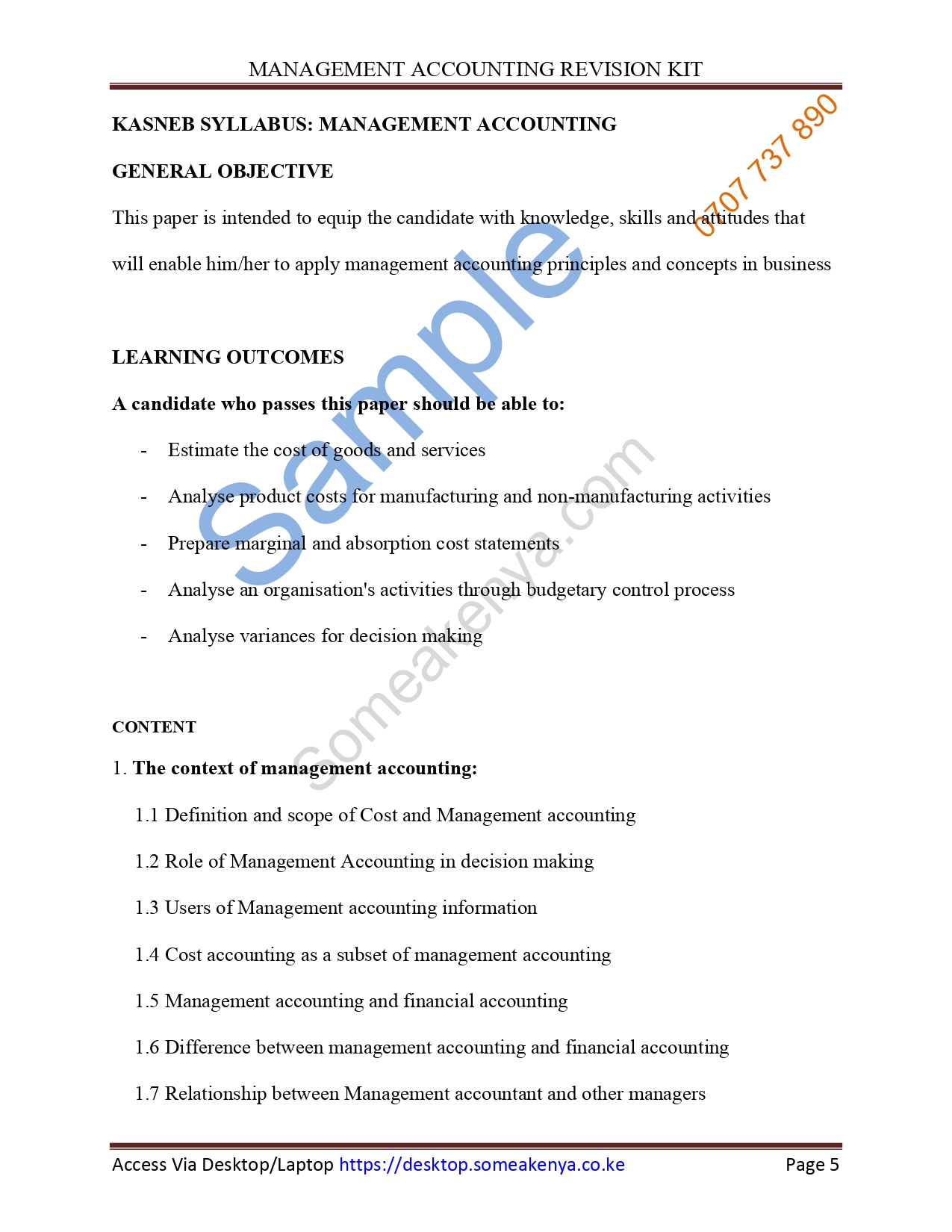
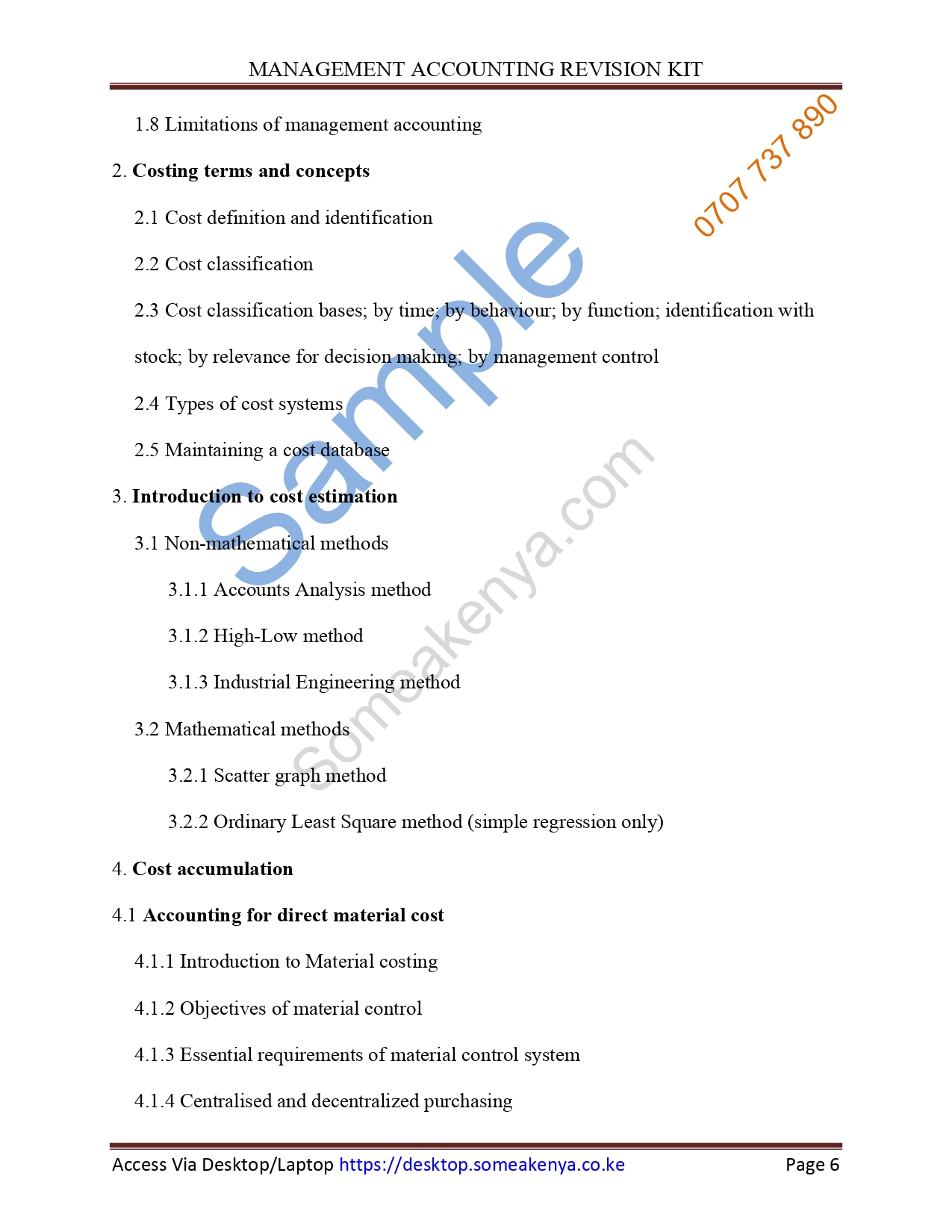
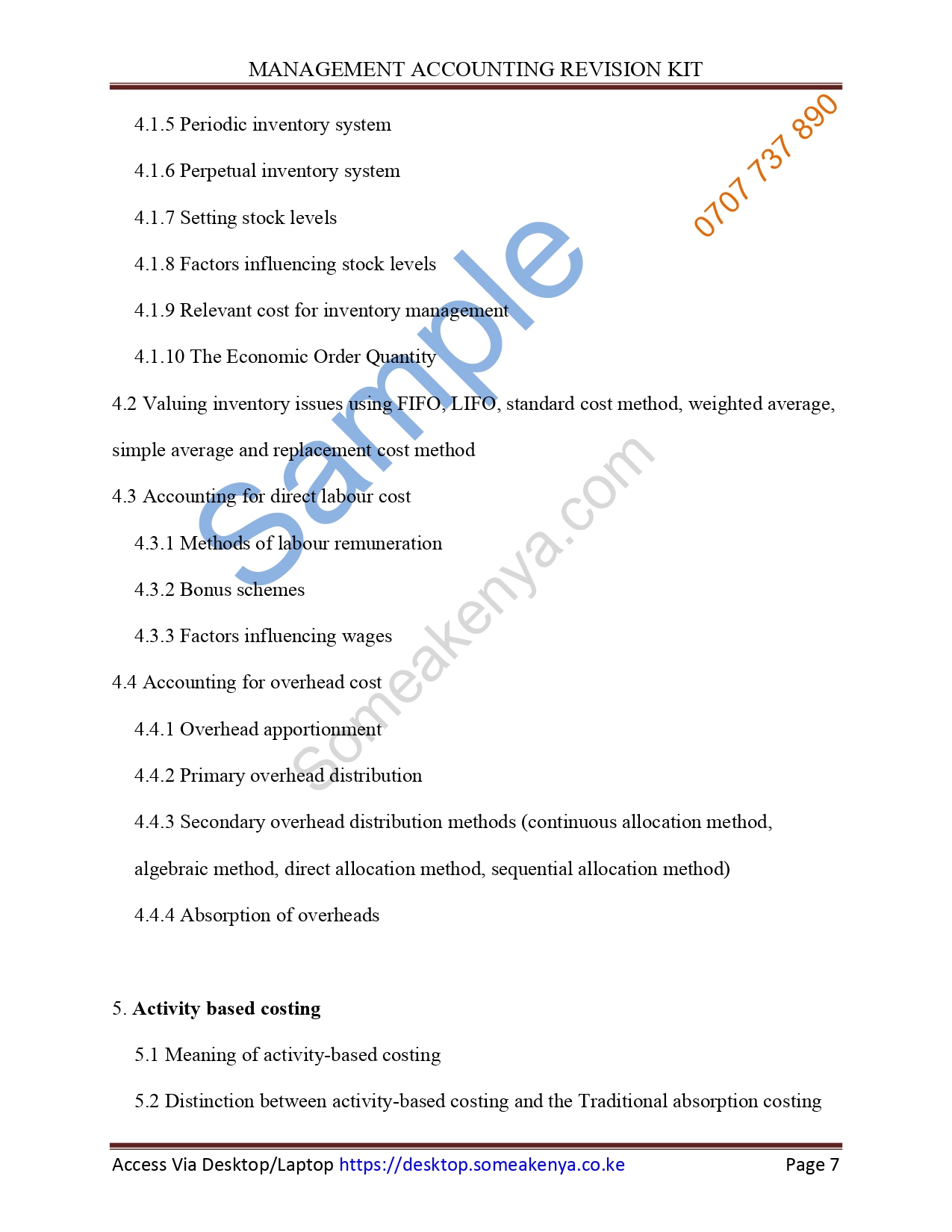
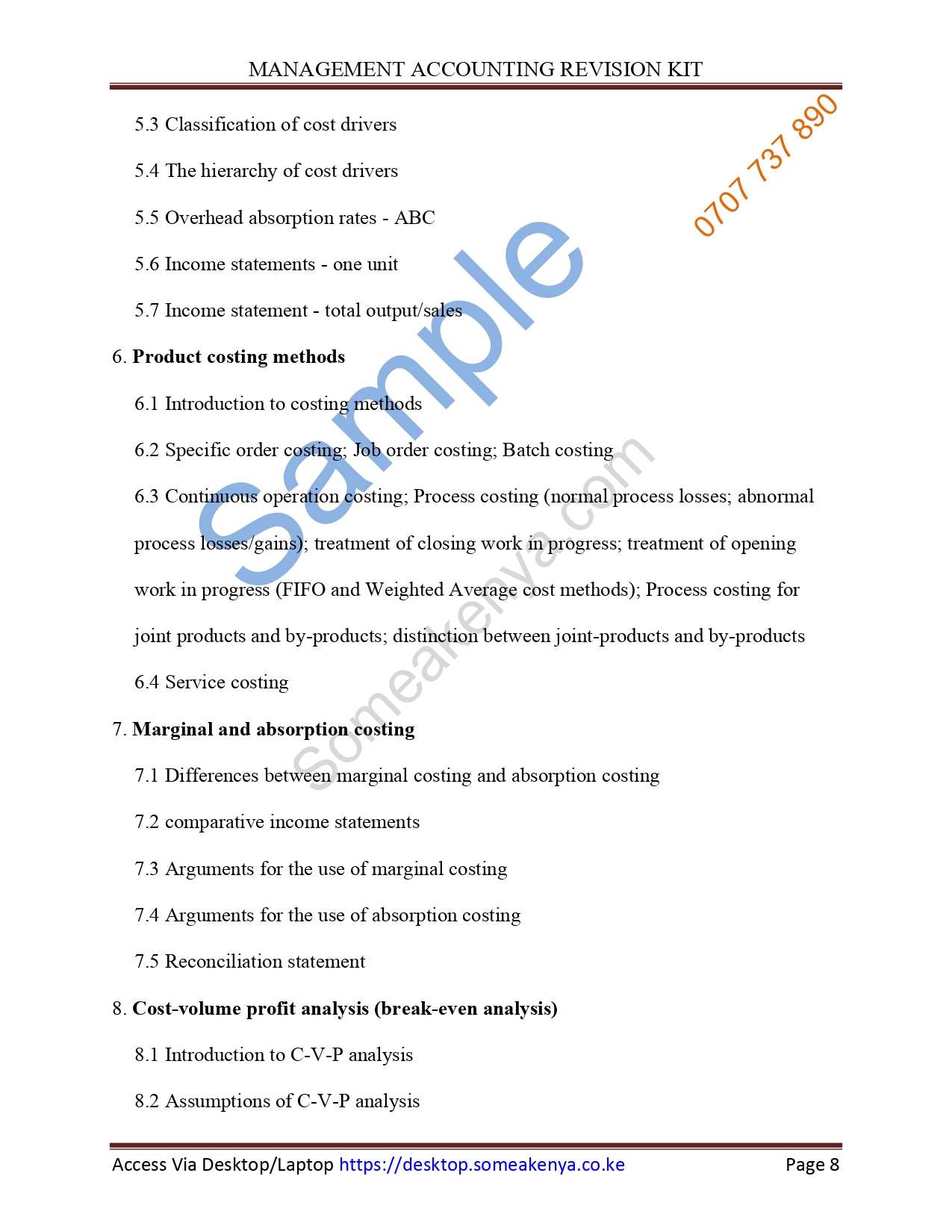
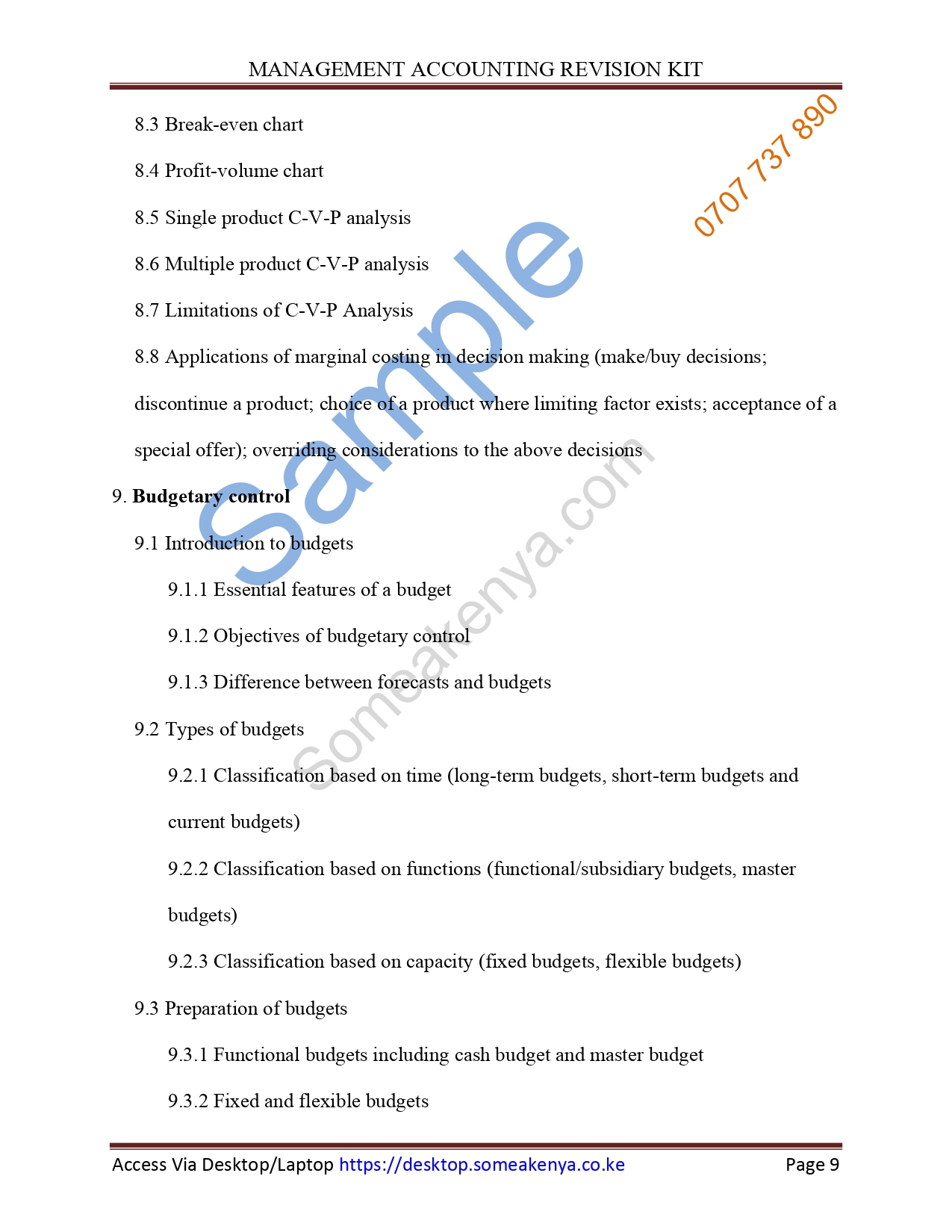
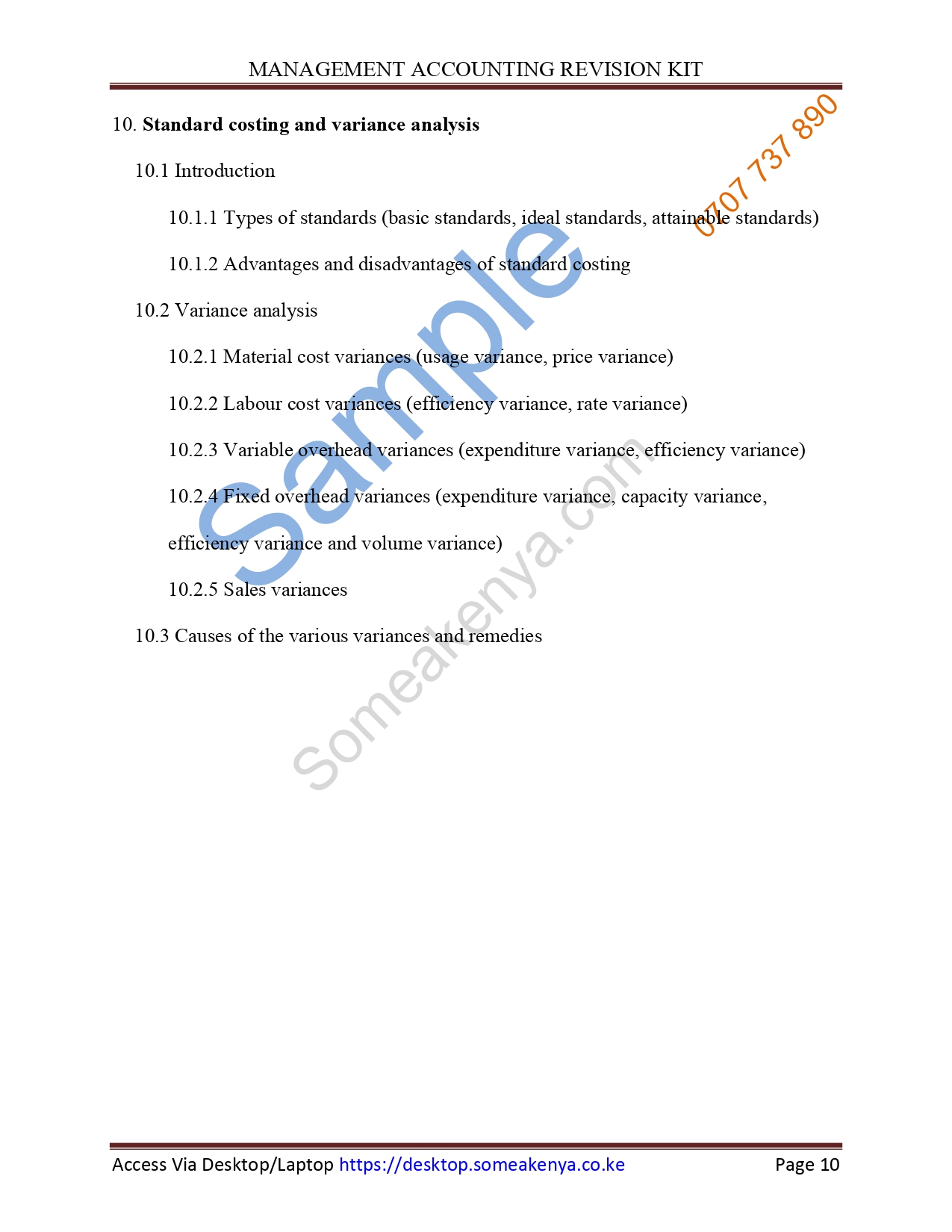
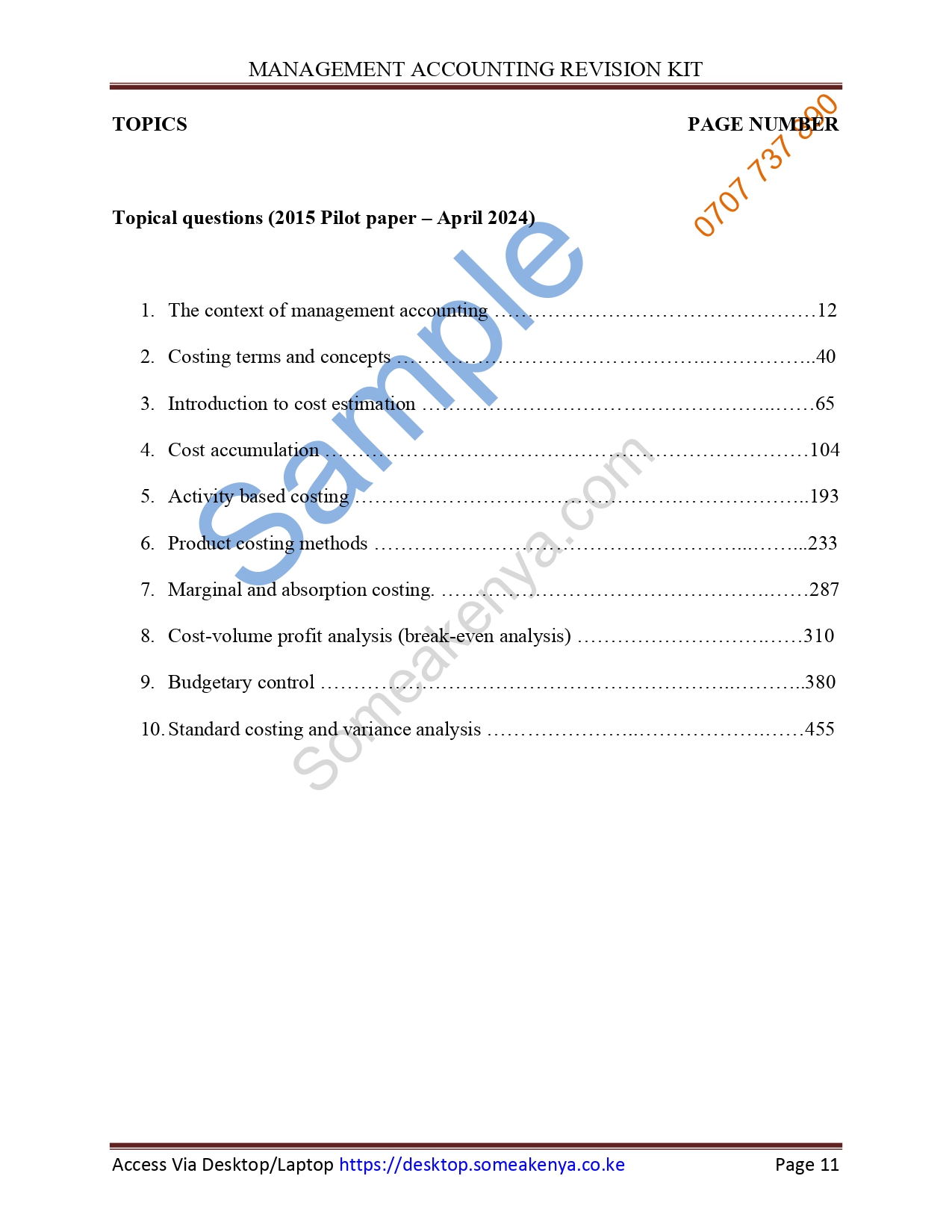
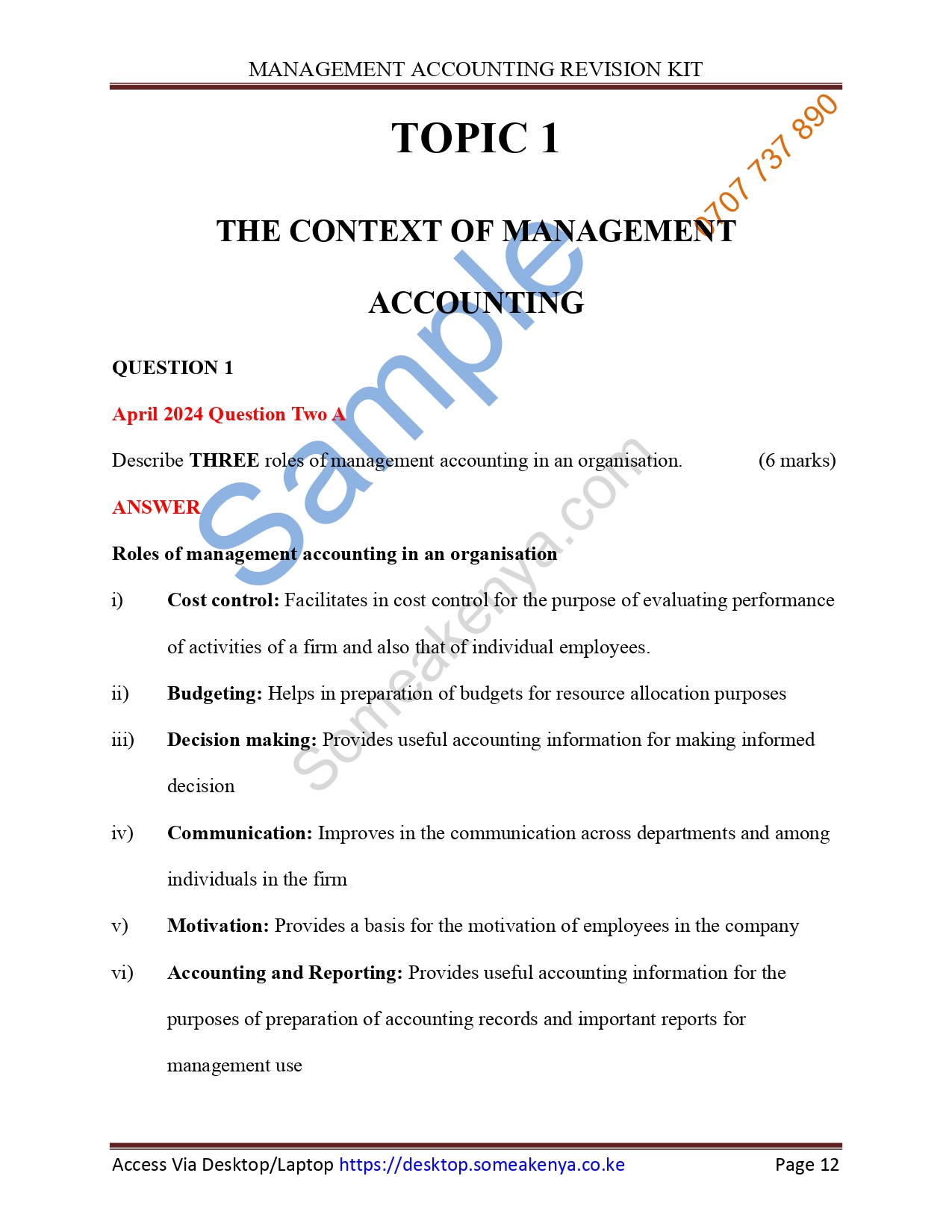
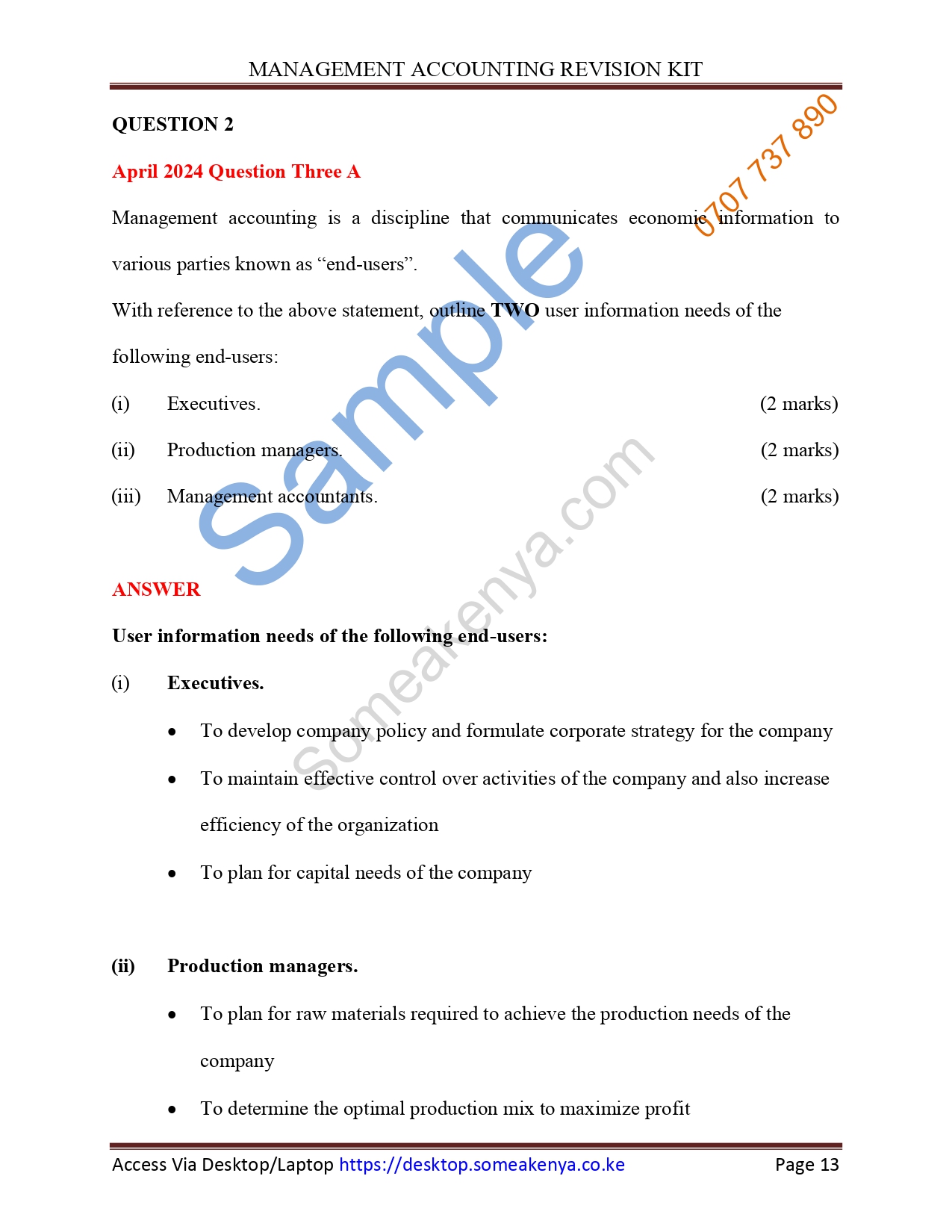



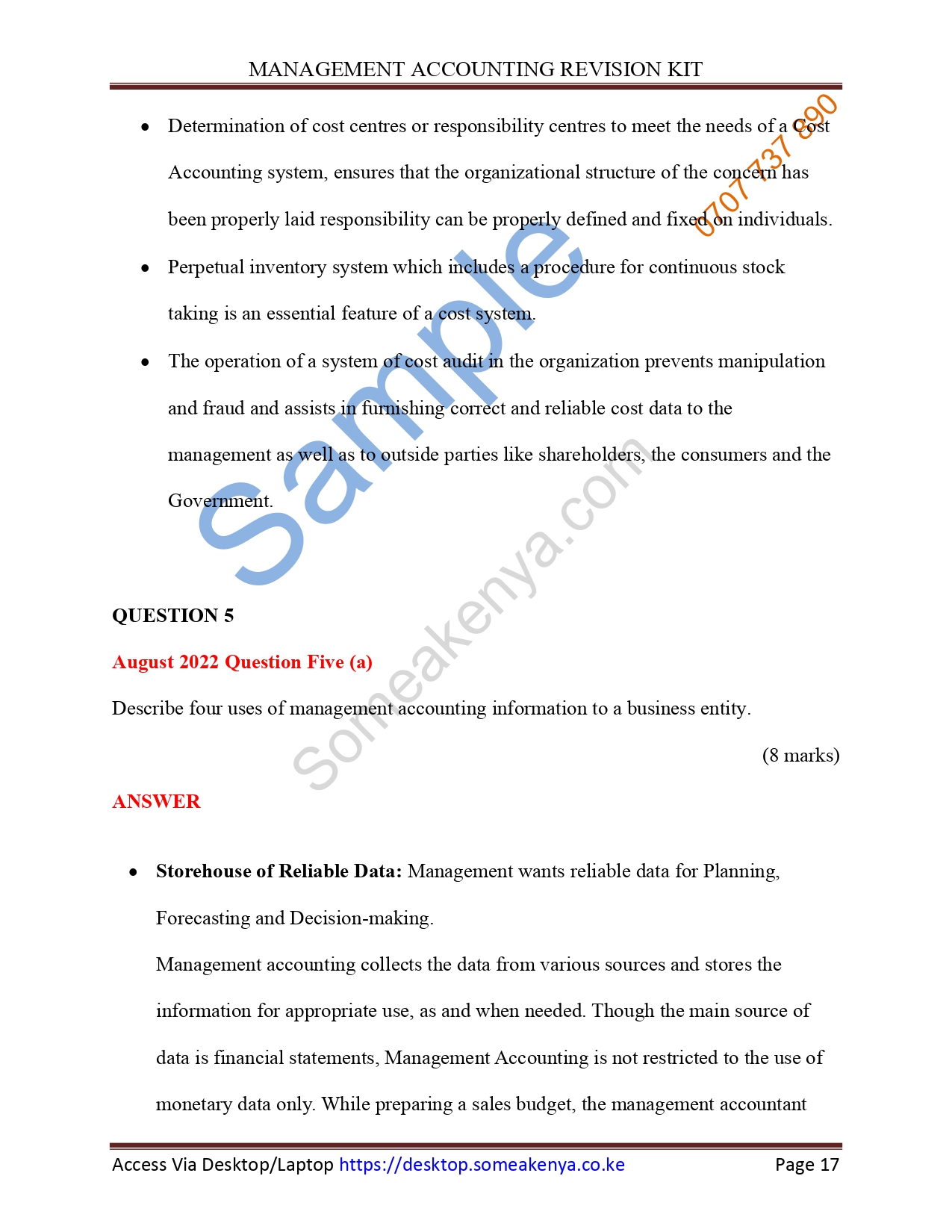
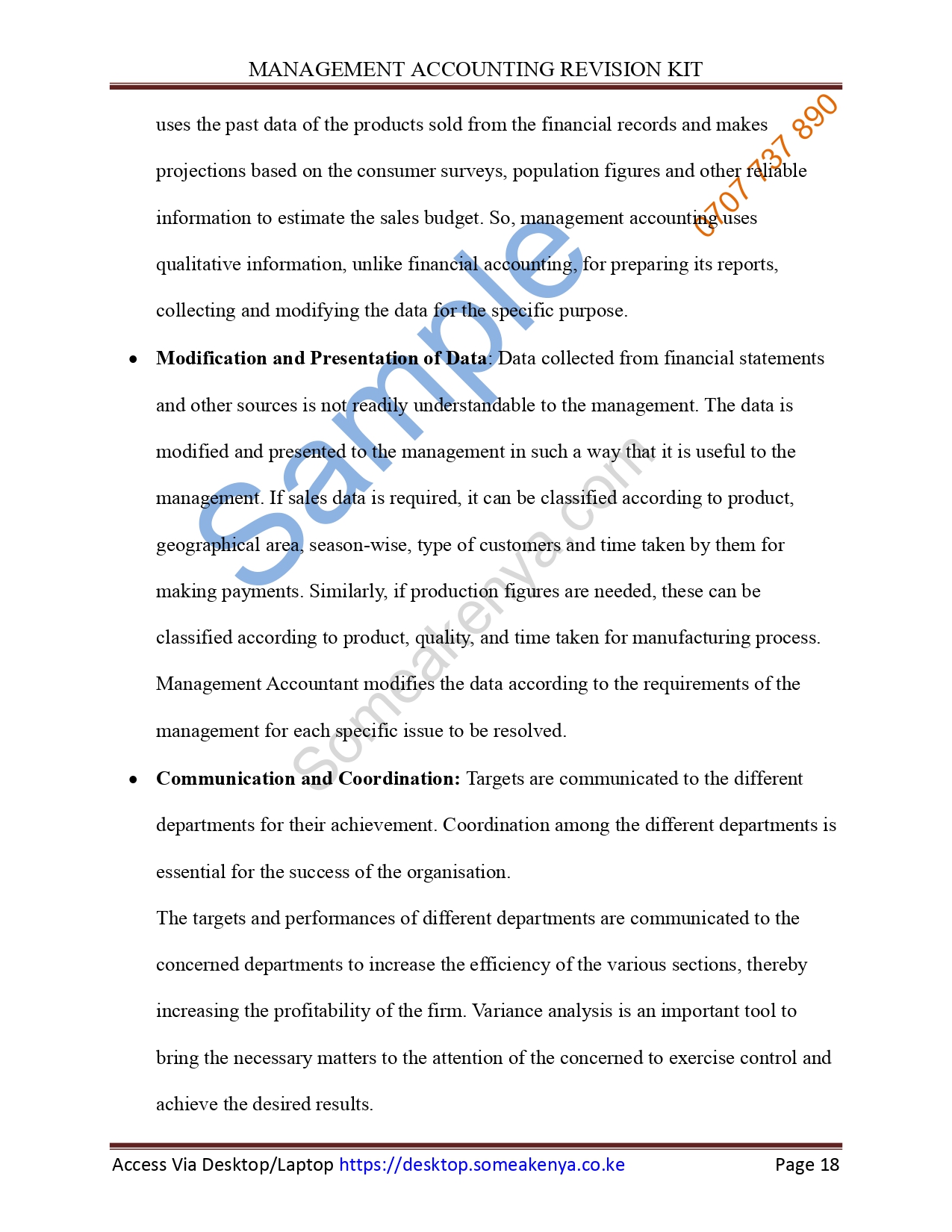
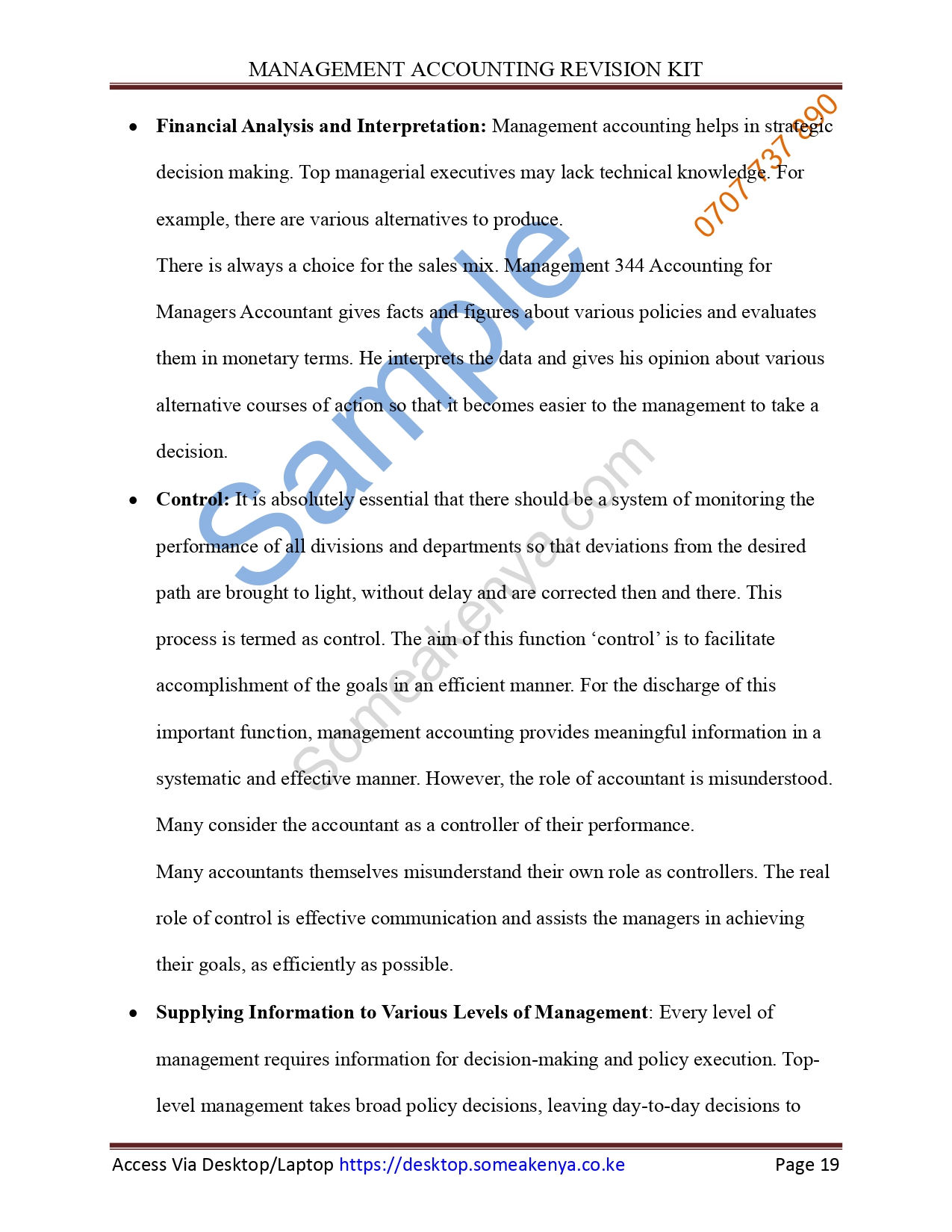

Full Access to these notes/Kit on Desktop/Laptop via https://desktop.someakenya.co.ke
Or through Our Mobile App
TOPIC 1
THE CONTEXT OF MANAGEMENT ACCOUNTING
QUESTION 1
August 2023 Question One A
Explain THREE limitations of financial accounting which are addressed by management accounting. (6 marks)
ANSWER
- Profitability: Financial accounting provides only limited information because it reveals the profitability of the company as a whole rather than in terms of its individual operations such as department or product.
- Performance measures: It considers only those transactions which can be expressed in terms of money or quantitatively expressed while it does not take into account qualitative information such as product quality, employee efficiency e.t.c
- Decision making: Provides limited information to management for decision making purposes. Nevertheless, the information provided sometimes is not relevant in the circumstance for making decisions.
- Its historical in nature and hence provides only a post mortem record of business transactions
QUESTION 2
December 2022 Question Five (b)
Highlight SIX benefits that a firm would derive from establishing a good cost accounting system. (6 marks)
ANSWER
- A cost system reveals unprofitable activities, losses or inefficiencies occurring in any form such as:
- Wastage of man power, idle time and lost time.
- Wastage of material in the form of spoilage, excessive scrap etc., and
- Wastage of resources, e.g. inadequate utilization of plant, machinery and other facilities.
- Cost Accounting locates the exact causes for decrease or increase in the profit or loss of the business. It identifies the unprofitable products or product lines so that these may be eliminated or alternative measures may be taken.
- Cost Accounts furnish suitable data and information to the management to serve as guides in making decisions involving financial considerations.
- Cost Accounting is useful for price fixation purposes. Although sale price is generally related more to economic conditions prevailing in the market than to cost, the latter serves as a guide to test the adequacy of selling prices.
- With the application of Standard Costing and Budgetary Control methods, the optimum level of efficiency is set.
- Cost comparison helps in cost control. Comparison may be period to period, of the figures in respect of the same unit or factory or of several units in an industry by employing Uniform Costs and Inter- Firm Comparison methods. Comparison may be made in respect of cost of jobs, process or cost centres.
- A cost system provides ready figures for use by the Government, wage tribunals and boards, and labour and trade unions.
- When a concern is not working to full capacity due to various reasons such as shortage of demands or bottlenecks in production, the cost of idle capacity can readily worked out and repealed to the management.
- Introduction of a cost reduction programme combined with operations research and value analysis techniques leads to economy.
- Marginal Costing is employed for suggesting courses of action to be taken. It is a useful tool for the management for making decisions.
- Determination of cost centres or responsibility centres to meet the needs of a Cost Accounting system, ensures that the organizational structure of the concern has been properly laid responsibility can be properly defined and fixed on individuals.
- Perpetual inventory system which includes a procedure for continuous stock taking is an essential feature of a cost system.
- The operation of a system of cost audit in the organization prevents manipulation and fraud and assists in furnishing correct and reliable cost data to the management as well as to outside parties like shareholders, the consumers and the Government.
QUESTION 3
August 2022 Question Five (a)
Describe four uses of management accounting information to a business entity.
(8 marks)
ANSWER
- Storehouse of Reliable Data: Management wants reliable data for Planning, Forecasting and Decision-making.
Management accounting collects the data from various sources and stores the information for appropriate use, as and when needed. Though the main source of data is financial statements, Management Accounting is not restricted to the use of monetary data only. While preparing a sales budget, the management accountant uses the past data of the products sold from the financial records and makes projections based on the consumer surveys, population figures and other reliable information to estimate the sales budget. So, management accounting uses qualitative information, unlike financial accounting, for preparing its reports, collecting and modifying the data for the specific purpose.
- Modification and Presentation of Data: Data collected from financial statements and other sources is not readily understandable to the management. The data is modified and presented to the management in such a way that it is useful to the management. If sales data is required, it can be classified according to product, geographical area, season-wise, type of customers and time taken by them for making payments. Similarly, if production figures are needed, these can be classified according to product, quality, and time taken for manufacturing process. Management Accountant modifies the data according to the requirements of the management for each specific issue to be resolved.
- Communication and Coordination: Targets are communicated to the different departments for their achievement. Coordination among the different departments is essential for the success of the organisation.
The targets and performances of different departments are communicated to the concerned departments to increase the efficiency of the various sections, thereby increasing the profitability of the firm. Variance analysis is an important tool to bring the necessary matters to the attention of the concerned to exercise control and achieve the desired results.
- Financial Analysis and Interpretation: Management accounting helps in strategic decision making. Top managerial executives may lack technical knowledge. For example, there are various alternatives to produce.
There is always a choice for the sales mix. Management 344 Accounting for Managers Accountant gives facts and figures about various policies and evaluates them in monetary terms. He interprets the data and gives his opinion about various alternative courses of action so that it becomes easier to the management to take a decision.
- Control: It is absolutely essential that there should be a system of monitoring the performance of all divisions and departments so that deviations from the desired path are brought to light, without delay and are corrected then and there. This process is termed as control. The aim of this function ‘control’ is to facilitate accomplishment of the goals in an efficient manner. For the discharge of this important function, management accounting provides meaningful information in a systematic and effective manner. However, the role of accountant is misunderstood. Many consider the accountant as a controller of their performance.
Many accountants themselves misunderstand their own role as controllers. The real role of control is effective communication and assists the managers in achieving their goals, as efficiently as possible.
- Supplying Information to Various Levels of Management: Every level of management requires information for decision-making and policy execution. Top-level management takes broad policy decisions, leaving day-to-day decisions to lower management for execution. Supply of right information, at proper time, increases efficiency at all levels.
- Reporting to Management: Reporting is an important function of management accounting to achieve the targets. The reports are presented in the form of graphs, diagrams and other statistical techniques so as to make them easily understandable. These reports may be monthly, quarterly, and half-yearly. These reports are helpful in
QUESTION 4
April 2022 Question One (a)
Cost accounting uses information provided by financial accounting together with other details of internal operations of an organisation.
With reference to the above statement, describe three similarities between cost accounting and financial accounting. (6 marks)
ANSWER
- Common Objective: Both cost accounting and financial accounting aim to provide relevant and accurate information for decision-making within an organization. While cost accounting focuses on internal management and cost control, financial accounting primarily focuses on external reporting to stakeholders.
- Use of Generally Accepted Accounting Principles (GAAP): Both cost accounting and financial accounting adhere to the principles and guidelines established by GAAP. GAAP ensures consistency and comparability of financial information, making it easier for stakeholders to analyze and interpret the data.
- Double-Entry System: Both cost accounting and financial accounting use the double-entry system of recording financial transactions. This system ensures that every transaction affects at least two accounts, maintaining the fundamental principle of balance in accounting.
- Recording Transactions: Both branches record financial transactions involving money, assets, liabilities, revenues, and expenses. They use journals and ledgers to record and classify these transactions.
- Importance of Accuracy: Accuracy is crucial in both cost accounting and financial accounting. In both cases, the information generated must be reliable and precise to facilitate effective decision-making and financial reporting.
- Analysis and Interpretation: Both cost accounting and financial accounting involve the analysis and interpretation of financial data. Cost accountants analyze costs and profitability at various levels, such as product, department, or process, while financial accountants analyze and interpret financial statements to assess the overall financial performance and position of an organization.
- Integration: While cost accounting and financial accounting have distinct focuses, they are often interconnected. Cost accounting data is used as input for financial accounting to determine the cost of goods sold, inventory valuation, and other financial statement components. The financial statements prepared by financial accounting, such as the income statement and balance sheet, can also provide valuable information for cost analysis and decision-making.
QUESTION 5
April 2022 Question Three (a)
Discuss four challenges that you are likely to encounter when installing a costing management system. (8 marks)
ANSWER
- Lack of Support from Top Management: Effective functioning of nay system requires wholehearted support from the management. Otherwise the system will fail or may not produce the desired results. Management has all responsibility to receive the reports and feed backs and take necessary actions on the reports. When management lacks interest in the system [i.e., may accept the system but may not encourage], the system will fail miserably.
- Lack of Cooperation from the Staff: The tendency of the staff is to resist any new system at the beginning and may not extend full cooperation for the system to function effectively. If the tendency continues further and refuse to cooperate then problems may arise.
- Different Authority Structure: The costing system may be based on formal authority structure, but in reality there may exist a different authority structure. For example, if trade unions have greater influence in the decision-making process, then the system may run into difficulties.
- Changing Environment: Changing environment has greater influence on business operations. The market may change, the production process may change and the management ideas may change. If the costing system fails to take account of the changes, then the system will fail to deliver the desired results and may run into difficulties.
- Lack of Overall Control on the System: The system should be watched continuously. When some part of the system breaks down, it should be set right then and there. Otherwise the whole system will break down. For example, if inventory is not properly controlled, then the whole material control system may break down. Ultimately the whole cost accounting system may fail.
- Lack of Clarity on Objectives: The cost accounting department staff should be clear about the priorities and objectives of the system. They should know the purpose of information collected and its end use. If not, they may not collect correct information or may send wrong or inadequate information.
QUESTION 6
December 2021 Question Five (a)
Describe four factors that could influence a company’s demand for management accounting information. (8 marks)
ANSWER
- Organizational Size and Complexity: Larger and more complex organizations typically have a greater demand for management accounting information. This is because they have more departments, processes, and activities to monitor and manage. The need for detailed cost information, performance measurement, and analysis becomes crucial in such organizations.
- Nature of the Industry: The industry in which a company operates can significantly impact the demand for management accounting information. Industries with intense competition, rapidly changing technology, or high market volatility often require more frequent and detailed information for decision-making. For example, a company operating in the technology sector may need real-time cost data to assess the profitability of its products and make timely pricing decisions.
- Business Strategy and Objectives: The strategic direction and goals of a company can influence the demand for management accounting information. For instance, if a company aims to differentiate itself through cost leadership, it will require detailed cost analysis to identify areas for cost reduction and efficiency improvement. On the other hand, a company pursuing a product differentiation strategy may focus more on customer profitability analysis and investment appraisal for new product development.
- Decision-Making Structure: The decision-making structure and hierarchy within a company can affect the demand for management accounting information. In decentralized organizations, where decision-making authority is distributed across various levels or departments, there is a greater need for relevant and timely information at each level to support decision-making. On the other hand, centralized decision-making structures may require less detailed information at lower levels.
- Regulatory and Compliance Requirements: Regulatory and compliance requirements imposed by government authorities or industry standards can influence the demand for management accounting information. Companies need to generate and provide specific financial and non-financial information to comply with regulations, such as tax reporting, environmental reporting, or industry-specific standards like International Financial Reporting Standards (IFRS) or Generally Accepted Accounting Principles (GAAP).
- External Stakeholder Needs: The demands and expectations of external stakeholders, such as investors, lenders, and shareholders, can influence the demand for management accounting information. If stakeholders require detailed information on cost structures, profitability analysis, or risk assessment, the company may need to provide such information to satisfy their needs and maintain transparency.
- Internal Decision-Making Needs: The specific decision-making needs within a company can determine the demand for management accounting information. Different departments or managers may require information related to budgeting, forecasting, performance evaluation, pricing decisions, product profitability, or capital investment analysis. The level of detail and frequency of reporting will depend on the specific decision-making requirements of different stakeholders within the organization.
QUESTION 7
September 2021 Question Two A
Examine four limitations of financial accounting that have made organisations introduce management accounting. (8 marks)
ANSWER
- It shows only Overall Performance – Financial Accounting provides information about profit, loss, cost etc., of the collective activities of the business as a whole. It does not provide data for each and every product, process, department or operation separately.
- It provides only Historical Data – Financial Accounting is historical in nature and it provides data of past activities. It does not provide current data which management requires for making effective plans for future. So it is rightly said that financial accounts provide only a post-mortem analysis of past activities. It does not help in fixation of selling price.
- It is Static in Nature – Modern business is dynamic and not static. Financial Accounts does not incorporate the changes that take place within the business.
- It fails to provide information for Price Fixation – In Financial Accounting; costs are not available by division, products, process etc. So, price fixation becomes difficult and estimates cannot be prepared.
- It fails to Control Cost – Financial Accounts fail to exercise control over materials, labour and other expenses incurred in a business enterprise. As a result, avoidable wastages and losses remain as it is under this system.
- No proper Classification of Costs – In Financial Accounting, expenses are not classified into direct and indirect, fixed and variable and controllable and uncontrollable. These classifications have utility of their own.
- It does not provide proper System for Performance Appraisal – In Financial Accounting there is no system of developing norms and standards to appraise the efficiency in the use of materials, labour and other costs by comparing the actual performance with what should have been accomplished during a given period of time.
- It fails to Analyse Losses – Financial Accounting does not fully analyse the losses due to idle time, idle plant capacities, inefficient labour, sub-standard materials etc.
KASNEB SYLLABUS: MANAGEMENT ACCOUNTING
GENERAL OBJECTIVE
This paper is intended to equip the candidate with knowledge, skills and attitudes that will enable him/her to apply management accounting principles and concepts in business
LEARNING OUTCOMES
A candidate who passes this paper should be able to:
- Estimate the cost of goods and services
- Analyse product costs for manufacturing and non-manufacturing activities
- Prepare marginal and absorption cost statements
- Analyse an organisation’s activities through budgetary control process
- Analyse variances for decision making
CONTENT
- The context of management accounting:
1.1 Definition and scope of Cost and Management accounting
1.2 Role of Management Accounting in decision making
1.3 Users of Management accounting information
1.4 Cost accounting as a subset of management accounting
1.5 Management accounting and financial accounting
1.6 Difference between management accounting and financial accounting
1.7 Relationship between Management accountant and other managers
1.8 Limitations of management accounting
- Costing terms and concepts
2.1 Cost definition and identification
2.2 Cost classification
2.3 Cost classification bases; by time; by behaviour; by function; identification with stock; by relevance for decision making; by management control
2.4 Types of cost systems
2.5 Maintaining a cost database
- Introduction to cost estimation
3.1 Non-mathematical methods
3.1.1 Accounts Analysis method
3.1.2 High-Low method
3.1.3 Industrial Engineering method
3.2 Mathematical methods
3.2.1 Scatter graph method
3.2.2 Ordinary Least Square method (simple regression only)
- Cost accumulation
4.1 Accounting for direct material cost
4.1.1 Introduction to Material costing
4.1.2 Objectives of material control
4.1.3 Essential requirements of material control system
4.1.4 Centralised and decentralized purchasing
4.1.5 Periodic inventory system
4.1.6 Perpetual inventory system
4.1.7 Setting stock levels
4.1.8 Factors influencing stock levels
4.1.9 Relevant cost for inventory management
4.1.10 The Economic Order Quantity
4.2 Valuing inventory issues using FIFO, LIFO, standard cost method, weighted average, simple average and replacement cost method
4.3 Accounting for direct labour cost
4.3.1 Methods of labour remuneration
4.3.2 Bonus schemes
4.3.3 Factors influencing wages
4.4 Accounting for overhead cost
4.4.1 Overhead apportionment
4.4.2 Primary overhead distribution
4.4.3 Secondary overhead distribution methods (continuous allocation method, algebraic method, direct allocation method, sequential allocation method)
4.4.4 Absorption of overheads
- Activity based costing
5.1 Meaning of activity-based costing
5.2 Distinction between activity-based costing and the Traditional absorption costing
5.3 Classification of cost drivers
5.4 The hierarchy of cost drivers
5.5 Overhead absorption rates – ABC
5.6 Income statements – one unit
5.7 Income statement – total output/sales
- Product costing methods
6.1 Introduction to costing methods
6.2 Specific order costing; Job order costing; Batch costing
6.3 Continuous operation costing; Process costing (normal process losses; abnormal process losses/gains); treatment of closing work in progress; treatment of opening work in progress (FIFO and Weighted Average cost methods); Process costing for joint products and by-products; distinction between joint-products and by-products
6.4 Service costing
- Marginal and absorption costing
7.1 Differences between marginal costing and absorption costing
7.2 comparative income statements
7.3 Arguments for the use of marginal costing
7.4 Arguments for the use of absorption costing
7.5 Reconciliation statement
- Cost-volume profit analysis (break-even analysis)
8.1 Introduction to C-V-P analysis
8.2 Assumptions of C-V-P analysis
8.3 Break-even chart
8.4 Profit-volume chart
8.5 Single product C-V-P analysis
8.6 Multiple product C-V-P analysis
8.7 Limitations of C-V-P Analysis
8.8 Applications of marginal costing in decision making (make/buy decisions; discontinue a product; choice of a product where limiting factor exists; acceptance of a special offer); overriding considerations to the above decisions
- Budgetary control
9.1 Introduction to budgets
9.1.1 Essential features of a budget
9.1.2 Objectives of budgetary control
9.1.3 Difference between forecasts and budgets
9.2 Types of budgets
9.2.1 Classification based on time (long-term budgets, short-term budgets and current budgets)
9.2.2 Classification based on functions (functional/subsidiary budgets, master budgets)
9.2.3 Classification based on capacity (fixed budgets, flexible budgets)
9.3 Preparation of budgets
9.3.1 Functional budgets including cash budget and master budget
9.3.2 Fixed and flexible budgets
- Standard costing and variance analysis
10.1 Introduction
10.1.1 Types of standards (basic standards, ideal standards, attainable standards)
10.1.2 Advantages and disadvantages of standard costing
10.2 Variance analysis
10.2.1 Material cost variances (usage variance, price variance)
10.2.2 Labour cost variances (efficiency variance, rate variance)
10.2.3 Variable overhead variances (expenditure variance, efficiency variance)
10.2.4 Fixed overhead variances (expenditure variance, capacity variance, efficiency variance and volume variance)
10.2.5 Sales variances
10.3 Causes of the various variances and remedies